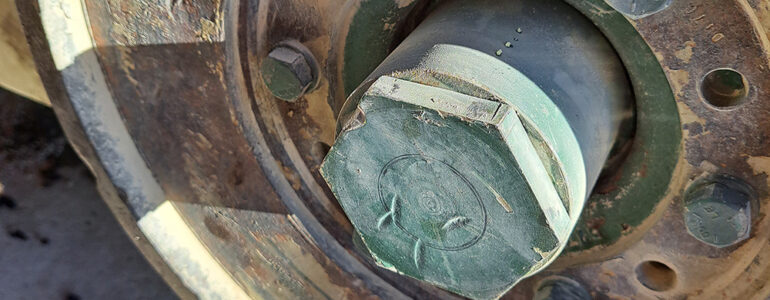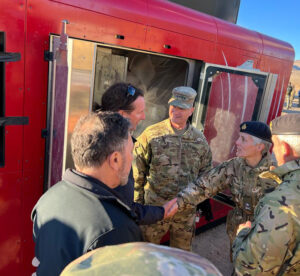Meet Multistation at AM Village 2024 | 13 -17 May | Tournai, Belgium
2/12/22

In collaboration with the British Army, SPEE3D demonstrated our WarpSPEE3D Printer at Project Convergence, showcasing the benefits of Additive Manufacturing technology to Defence.
This month, the SPEE3D team were at Fort Irwin with the REME soldiers from the British Army, making parts of consequence for a multi-national training force. Due to the world-leading, high-speed capabilities of our technology, the British Army requested our support to provide a cold spray metal manufacturing capability that could be used throughout the U.S. Army Future Command’s Project Convergence 2022, as part of a concept assessment.
As one of the first additive manufacturing companies to partner with the British Army, together, we showcased the WarpSPEE3D printer’s deployable technology to print metal 3D printed parts in the field, and in various conditions throughout the exercise.
While at Project Convergence this year, WarpSPEE3D generated parts successfully in the harsh, desert conditions at Fort Irwin, demonstrating the robust, expeditionary capabilities of our technology, and how metal 3D printing can leverage supply chain readiness for Defence.
A small selection of dozens of armoured vehicle applications manufactured at Project Convergence using WarpSPEE3D.
The U.S. Army’s Futures Command Project Convergence is a flagship learning, experimentation, and demonstration campaign. From October 30 to November 9, 2022, in Fort Irwin, California, Project Convergence aimed to evaluate approximately 300 technologies, focusing on advancing joint and multinational interoperability in future operational environments. Several thousand U.S., U.K., and Australian service members, researchers, and industry partners were there to experiment with – and assess – these new advancements. The campaign brought together leading-edge technology from the US, UK & Australia to one training environment.
“We are thrilled to be invited by the British Army to collaborate and explore the capabilities and logistical impact of our additive manufacturing technology for the military. Our partnership over the last two years with them has validated the need for 3D metal printing to solve a myriad of challenges the military faces, and in rough terrain where they need a deployable and easy-to-use solution to print important parts quickly.” – Byron Kennedy, Co-Founder, and CEO of SPEE3D.
“SPEE3D regularly works with defence worldwide to showcase their innovative additive manufacturing technologies to help solve some of the military’s most pressing supply chain issues. It’s our pleasure to be able to work with SPEE3D, giving the British Army the opportunity to learn lessons from a world-leading additive manufacturing company”. – British Army’s Lieutenant Colonel Davidson Reith.
During the joint exercise, SPEE3D and the British Army collaborated on creating dozens of applications for various armoured vehicles over the campaign’s two weeks.
While out in the field, one of many parts the SPEE3D and British Army team printed was this M109 specialist tool. At the request of the US Army, this specialist tool was able to be designed in just 9 minutes. It was then printed in 30 minutes and heat-treated in just under two hours all while in the field.
Aluminium 6061 M109 specialist tool printed on WarpSPEE3D. Print time: 30 minutes. Print weight: 600g/1.3lbs.
Another part WarpSPEE3D manufactured was this CVRT main drive sprocket wheel. This application is often damaged when used in the field. During Project Convergence, the team designed it in minutes; it was then printed in just over 2 hours on WarpSPEE3D, and heat treated in less than two hours before being put to use while on site.
Another impressive set of large parts metal 3D printed at Project Convergence 2022 were this UK Warrior IFV Front Towing Eye and US HEMTT A4 Truck Tie Down Bow Shackle. These parts assist with the recovery of damaged, immobile vehicles in the field. Both parts have a combined print time of 8 hours, before being heat-treated and machined on site.
Aluminium 6061 UK Warrior IFV Front Towing Eye. Print time: 5 hours. Print weight: 6kg/13.2lbs.
Aluminium 6061 US HEMTT A4 Truck Tie Down Bow Shackle. Print time: 2.5 hours. Print weight: 3kg/6.6lbs.
These were some of many parts we and the British Army produced over the course of the trial, demonstrating how our patented cold spray technology can be used in harsh conditions to manufacture critical parts on site. With such a quick turnaround time, the ability to produce replacement parts in hours can significantly help improve vehicle readiness when needed for soldiers while on the front line.
While at Project Convergence, we were also fortunate to receive several visits from key Defence representatives. At Project Convergence’s Distinguished Visitors’ Day, we had the opportunity to brief US Space Command’s General David D. Thompson (Vice Chief of Space Operations) on SPEE3D’s recent hot fire test; and the ability for cold-spray to manufacture demanding space components potentially more rapidly and at lower cost compared to existing technologies.
Calum Stewart, SPEE3D’s Director of Defence Programmes in Europe meeting with US Space Command’s General David D. Thompson and showcasing the various applications the British Army and SPEE3D team have printed using WarpSPEE3D at Project Convergence 2022.
On the day, Commanding General U.S. Army Materiel Command (General Edward Daly), and UK Deputy Chief of the General Staff (Sharon Nesmith) had also visited our CEO, Byron Kennedy, who briefed on the impact that expeditionary manufacturing, and in particular cold spray, is having on current Defence supply chains.

Project Convergence offered SPEE3D the opportunity to demonstrate the impact that our patented cold-spray technology can have on military supply chains. This collaboration with the British Army is an example of our on-going and world-leading advanced manufacturing work with global Defence Forces. In September, our WarpSPEE3D was the first metal 3D printer in the world to be able to successfully manufacture metal parts on a U.S. Naval ship during the US Navy’s REPTX trial. Then just last month, we unveiled XSPEE3D – the world’s fastest all-in-one containerised metal 3D printer that is highly mobile, easy to use, and can print parts from anywhere in minutes. XSPEE3D was developed specifically for the military based on our experiences with the Australian Army during their world-first metal 3D printing field trials during 2020 and 2021.
XSPEE3D – our newest expeditionary metal 3D printer with all printing capability and auxiliary equipment in one.
Our unique, patented technology is 1,000 times faster than traditional 3D metal printing. Enabling the world’s most affordable additive manufacturing process to produce industrial quality metal parts from anywhere in just minutes. Our process operates with compressed air and electricity, and so does not rely on helium or other gasses, unlike large additive manufacturing printers. With the release of our Phaser Nozzle announced earlier this year, our process can currently produce parts from over 12 material sets, including copper, stainless steel, titanium, high-strength aluminum, and nickel-based carbides, with more in development.
Article from our partner Spee3D